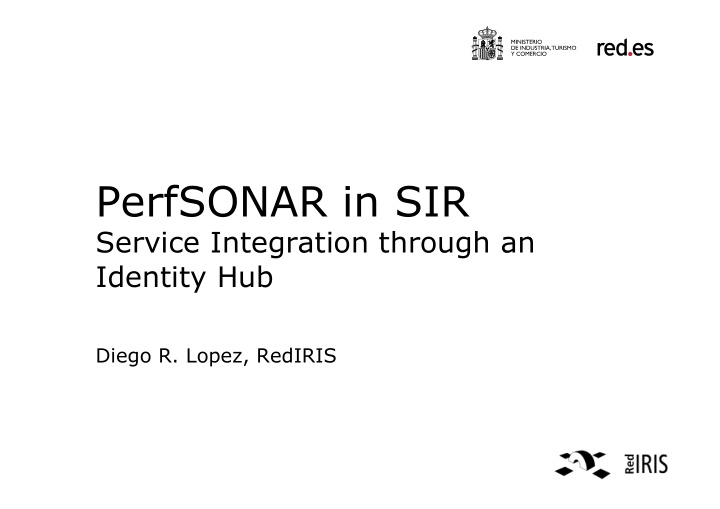



PerfSONAR in SIR Service Integration through an Identity Hub Diego R. Lopez, RedIRIS
PerfSONAR AAI • WS infrastructure • Security based on tokens Which component On behalf of whom Reference for additional attribute retrieval • Two kind of tokens X509 certificates SAML assertions • Converging to a STS Both SOAP-oriented and RESTful
Using the PS Security Tokens Subject NameIdentifier Subject NameIdentifier
PerfSONAR AA Profiles • AC Autonomous components Token (X.509) pre-installed in the component • WE Applications at web portals SAML assertion derived from federated authentication • UbC Stand-alone client with a GUI X.509 token dynamically built via SASL New mechanisms under development
Struggling with UbC • Deploy and configure a SASL online CA Including a signing certificate Direct access to user credentials Able to provide a session to user attributes • Deployment has been hampered because of this Practically, a single SASLCA (at GIdP) • New profile(s) to solve or alleviate this Using SAML tokens With a general STS as the long-term solution • In the mid-term, make use of already existing identity exchange infrastructures DAMe-based authentication SAML ECP Good-ole HTTP Auth
Applying DAMe
Applying ECP
SIR Servicio de Identidad de RedIRIS • Provide a single entry point to digital identity services for the academic community • Multiprotocol Simplify management Guarantee evolution • Flexible Compatible with any level of IdM deployment Able to live in parallel with other infrastructures http://www.rediris.es/sir/
The SIR Model One Ring to bring them all and in the darkness bind them In the Land of Mordor where the Shadows lie.
The Hub Concept • Simplifies initial adoption Flattening the learning curve • Provides additional services Building the case for federated ID • Offers a long-term solution Easy management Seamless evolution Keeping the federation promise • Adaptable to many kind of institutions From well-staffed, big universities To small-sized research institutes
Why the PAPI Protocol • Painless trust model • Lightweight transport • Easy deployment • Well-known by our community • Installed base
IdPs in SIR • Based on connectors Associated to institutional access / SSO system Able to produce assertions in the PAPI v1 protocol PHP, Java (JSP & Filter), Apache mod_perl, ASP, Sun AM, OSSO and some specific ones Community process for developing new ones • Extensible attribute flow Minimum set of attributes in the iris-* schema Any other can be sent Retrieved by the connector from the environment and/ or Id repositories
SPs in SIR • PAPI PoAs using the SIR GPoA as authoritative source GPoA metadata available at the SIR site Connectors available in Perl, PHP, Java and ASP.Net • SAML SPs of external providers Metadata is internally used by SIR adaptation layer • SAML SPs of participating institutions Metadata integrated with the IdP SAML metadata set • Any OpenID relying party No metadata (for the moment…)
The Policy • ASAP (The `S´ is for simple) This is a data transport infrastructure Signature of an agreement Explicit liability disclaimer • IdPs Restricted to institutions in the RedIRIS constituency PAPI trust material (public key) Acknowledgement of the conditions of use Explicit description of the data protection measures • SPs Acceptance of the metadata Declaration of the endpoints and consumed attributes Acknowledgement of the conditions of use
Bringing PerfSONAR to SIR • Already implemented for other WS-based services • Including support for a SASL CA in the SIR SP set Deploy the SASL CA software Extending the JAAS PAPI connector • Deploying IdP connectors supporting HTTP Auth Already existing ones Lightweight PHP application • Taking advantage of SIR location services Local-username@Local-domain Up to each domain whether usual passwords can be applied
SIR-enabled PerfSONAR
As Conclusion • PerfSONAR AA mechanisms still evolving Identity federation integration not as easy as planned Clear evolution path ahead • Initial deployment for singular projects supported by the GÉANT infrastructure (GIdP) • A wider deployment at the NREN level requires adapting federations to current AA profiles • The hub approach simplifies adaptation In depth, minimizing software changes In breadth, allowing adoption by any kind of institution
Recommend
More recommend